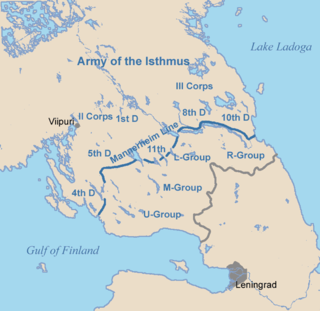
The Winter War was a war between the Soviet Union and Finland. The war began with a Soviet invasion of Finland on 30 November 1939, three months after the outbreak of World War II, and ended three and a half months later with the Moscow Peace Treaty on 13 March 1940. Despite superior military strength, especially in tanks and aircraft, the Soviet Union suffered severe losses and initially made little headway. The League of Nations deemed the attack illegal and expelled the Soviet Union.

Hjalmar Fridolf Siilasvuo was a Finnish lieutenant general, a knight of the Mannerheim Cross and a member of the Jäger Movement. He participated in the Eastern Front of World War I, the Finnish Civil War, the Winter War, Continuation War and the Lapland War.

The Finnish Army is the land forces branch of the Finnish Defence Forces. The Finnish Army is divided into six branches: the infantry, field artillery, anti-aircraft artillery, engineers, signals, and materiel troops. The commander of the Finnish Army since 1 January 2022 is Lieutenant General Pasi Välimäki.
The II Corps was a unit of the Finnish Army during the Winter War.
The III Corps was a corps of the Finnish Army during the Continuation War, where Finland fought alongside Nazi Germany against the Soviet Union. Formed from the peacetime V Corps and subordinated to the German Army High Command Norway, III Corps fought initially in northern Finland on the flank of the German XXXVI Corps, participating in the Finno-German Operation Arctic Fox. In February 1944, it was moved to the Karelian Isthmus just prior to the launch of the Soviet Vyborg–Petrozavodsk offensive. Following the Moscow Armistice, III Corps took overall command of the Finnish forces participating in the Lapland War, the removal of German forces from northern Finland.

Operation Silver Fox from 29 June to 17 November 1941, was a joint German–Finnish military operation during the Continuation War on the Eastern Front of World War II against the Soviet Union. The objective of the offensive was to cut off and capture the key Soviet Port of Murmansk through attacks from Finnish and Norwegian territory.
The XXXVI Corps was a German military formation in World War II.

The Army of the Isthmus was a formation of the Finnish Army during the Winter War. It was stationed on the Karelian Isthmus and was the largest formation of the Finnish Army, as it was charged to defend the important isthmus.
The IV Corps was a formation of the Finnish Army during the Winter War against the Soviet Union. It defended the area north of Lake Ladoga against Soviet attacks. It was commanded by Major General Juho Heiskanen and from 4 December 1939 by Major General Woldemar Hägglund. The IV Corps defeated superior Soviet troops by using motti tactics.
The I Corps was a formation of the Finnish Army during the Winter War. It was formed on February 25 from parts of the II Corps which had become too large to function properly. It fought during the final stages of the war on the front north of Viipuri.

The 7th Army was a Soviet Red Army field army during World War II, primarily against Finland. It was disbanded in 1944.
The 8th Army was a field army of the Soviet Red Army during the Second World War.
The 1st Army Corps was an army corps of the Soviet Armed Forces. It was formed in 1957 and finally deactivated in 1991. It draws its history from the 1st Rifle Corps, formed in 1922. Troops of the 1st Rifle Corps participated in the Winter War and World War II.
The 290th Infantry Division was a German infantry division in World War II. It was formed in the Munster Training Area in Wehrkreis X on 6 February 1940 and surrendered to Soviet forces at the end of the war as part of Army Group Courland.
The 142nd Rifle Division began service in August 1939 as a standard Red Army rifle division, which participated in the Winter War against Finland. It remained on the Karelian Isthmus and had a relatively uneventful war facing the Finns until the Vyborg–Petrozavodsk Offensive began on June 10, 1944, from which point it saw much more active service. Following the end of the Continuation War, the division was transferred to 2nd Shock Army in 2nd Belorussian Front. Its soldiers distinguished themselves in the capture of the German city of Graudenz and ended the war fighting through Pomerania.
The 49th Rifle Division was a Soviet Army infantry division, formed three times. First formed as a territorial division in 1931, the 49th Rifle Division's first formation became a regular division by 1939 and fought in the Winter War. For its actions during the war, it was awarded the Order of the Red Banner. However, the 49th Rifle Division was wiped out during the first ten days of Operation Barbarossa. Its second formation occurred in December 1941 and fought at Stalingrad, Kursk, the Vistula-Oder Offensive and the Battle of Berlin. The second formation was disbanded in 1946. The division was reformed in 1955 by renaming the 295th Rifle Division and became the 49th Motor Rifle Division in 1957.
The 50th Rifle Division was an infantry division of the Red Army from 1936 to 1946. The division took part in the Soviet invasion of Poland and the Winter War. After Germany launched Operation Barbarossa, the 50th fought in the Battle of Moscow, the Battles of Rzhev, the Donbass Strategic Offensive, the Dnieper–Carpathian Offensive, the First and Second Jassy–Kishinev Offensive, the Vistula–Oder Offensive and the Berlin Offensive.
The 7th Division was a unit of the Finnish Army during the Winter War. It was formed in January 1940 by renumbering the 10th Division in the hope of convincing the Soviets that it had been replaced by fresh troops. The unit was commanded throughout the rest of the Winter War by Major-General Einar Vihma.





